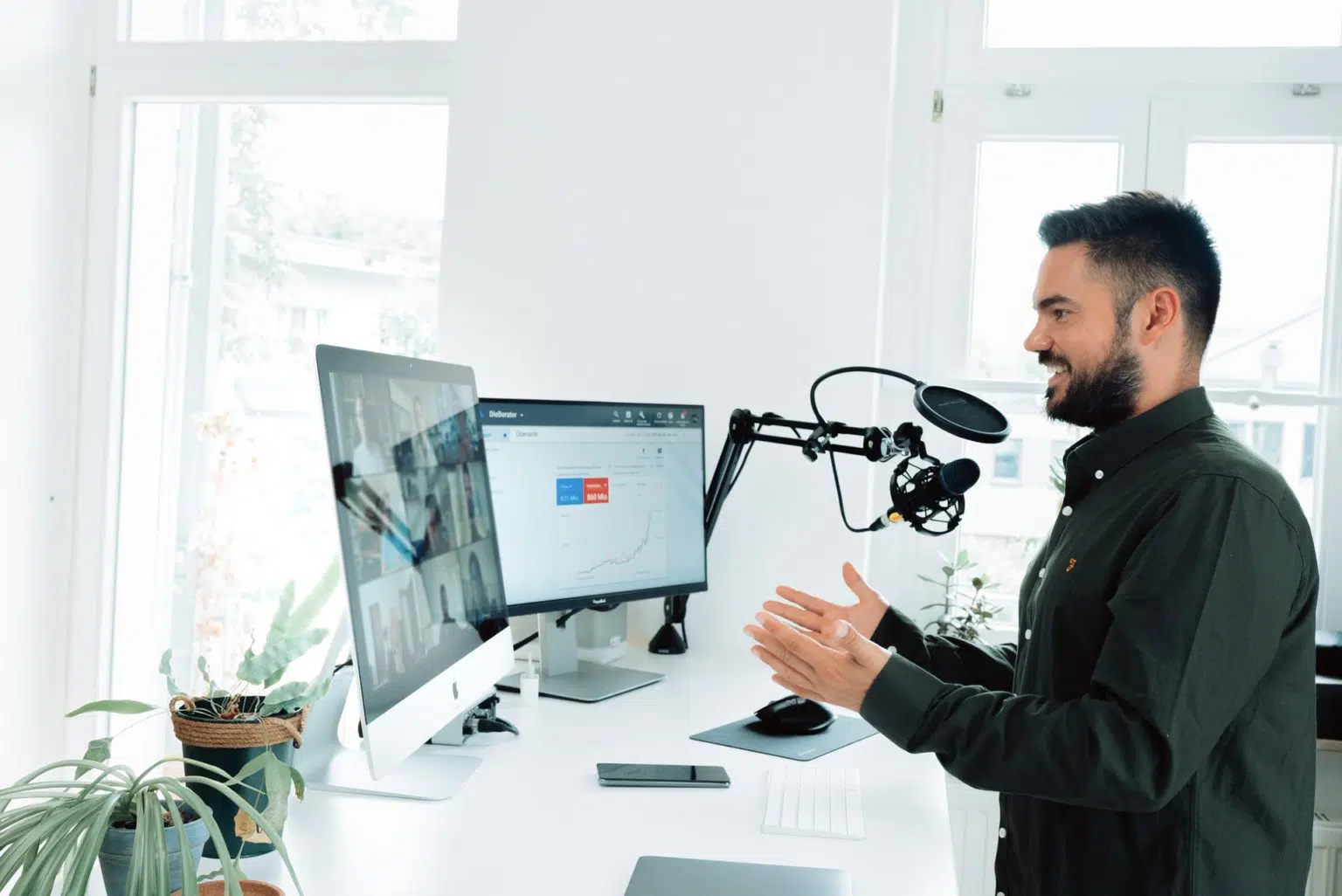7 steps to creating awesome webinars that convert
Webinars are one of the most effective tools to generate new leads and nurture existing ones. This guide will walk you through how to create a webinar that converts.

Webinars are one of the most effective tools to generate new leads and nurture existing ones.
They are a cost-effective resource that showcases your in-house expertise and also provides you with an endless supply of evergreen assets that can educate your audience.
However, to create an awesome webinar that converts your audience, you need to ensure that it is effectively engaging, and relevant to your customer’s needs and desires.
This guide will help you to set up and begin planning your next webinar to support your demand generation activities.
Steps to creating an effective webinar
- Choose the right topic
- Select an appropriate format
- Build your team
- Plan the right day and time
- Produce the content
- Promote your webinar
- Follow up with your audience
1. Choose the right topic
The key to a successful webinar lives and dies with the right topic.
Unlike other forms of content distribution, webinars are a significant investment of your audience’s time, so it’s important to ensure that you are demonstrating value out of the gate with an interesting and engaging topic.
The topic you choose should be highly relatable to the challenges of your audience and be highly specific in answering a question they typically ask.
For example, if you’re hosting a webinar on data compliance, you can choose to focus on a specific regulation in particular.
The mark of an effective webinar topic will be if it passes the “30-minute test”.
Are you confident that:
- you can speak about the topic in an engaging way for 30 minutes?
- your audience will pay attention to the topic for 30 minutes?
If the answer to either of these questions is no, then it’d be worth choosing another topic.
It’s also incredibly valuable to align the topic of your webinar to the conversations your sales team are already having with your customers to ensure that your sales reps can refer leads to your content, and receive appropriately qualified opportunities directly from the content as well.
2. Select an appropriate format
There are a plethora of webinar formats to choose from, including:
- Panel discussions
- Presentations
- Q&As
- Interviews
- Product demos
- Case studies
The format you select will depend on the objectives of your campaign.
For example, if the goal of your webinar is to showcase your organisation as an expert in your field, then panel discussions or a single/multi-speaker presentation would be the way to go.
If the objective is to build product demand, then we’d recommend showcasing a case study or product demo, to show your audience how your brand’s offering will solve their challenges.
Also, consider how you will host the webinar. Popular tools include; Zoom, Zoho Meeting, Riverside, Livestorm, Demio and Webinar Jam.
3. Build your team

Typically, you’d need to choose four people:
- The organiser – will handle all of the planning, from content creation to logistics. They will usually be the primary contact within the webinar platform.
- The presenter – is the subject matter expert, this could be either someone in your company (such as a sales or product team member), or an external thought leader.
- The moderator – is vital for panel discussions, moderators help to ensure conversation flows during discussions and that panellists stay on topic.
- The assistant – someone to support with technical issues. We’re sure it’ll be fine, but it never hurts to be too prepared!
4. Plan the right day and time
Sadly, marketing isn’t Field of Dreams.
Just because you’ve built a webinar, it doesn’t mean your audience will come.
Your customers lead busy lives, so it’s important that you’re speaking to them at a time that best suits them.
Mondays tend to not be great days for webinars, as many professionals are getting ready for the week ahead, and likewise, Fridays can be difficult as people begin to wind up for the weekend.
ON24 reports that Wednesdays and Thursdays are the best days to host webinars, with 11 AM being the best time.
A great way to choose a time that’s right for your audience is to use tools such as Google Analytics to monitor when users are frequently visiting your content, and plan around this.
5. Produce the content
Once you’ve come up with a topic, put your dream team together, and selected a time and date, the next step is to create your content.
The type of content you produce will depend entirely on the format you decided on in step two. For example, if you’ve chosen to do a single/multi-speaker presentation, then PowerPoint will be the way to go.
Or, if you’ve chosen to host a live Q&A, you will need to map out your questions and prepare the panel for the big day.
Here are our top tips for engaging webinar content:
- Less is more – try not to put the whole script on the slide, use images and short sentences to emphasise your points. GIFs are also excellent for providing humour and breaking the ice.
- Tell a story – ensure that your webinar has a structured beginning, middle and end. For example, outlining the challenge, providing the solution, and finally showcasing the result.
- Stay on point – try to keep on topic throughout the presentation. It can be easy to begin talking about other topics as you tell your story, but this can distract your audience from the message you want them to take away.
We also cannot stress how important it is to practice your webinar before the event.
It’s a fact of life that things can go wrong, especially when there are a lot of moving parts such as during a webinar.
Make sure to test all of your equipment before the webinar to avoid any technological mishaps, and do at least 1 to 2 test runs to ensure the team feels confident in performing their roles on the day.

6. Promote your webinar
Now that the webinar is ready, now you need people to see it.
To promote your webinar, you will need a landing page that can be used as a hub for people to sign up, as well as to distribute across your marketing channels.
- Email – your existing subscribers are a great source of engaged contacts to sign up for your webinar, email marketing will also help your sales team open up conversations with previously unconverted opportunities.
- Social Media – distribute your content both via organic and paid social media channels to build awareness amongst your target audience groups. Ensure your panellists and presenters are also presenting the webinar on their own networks.
- Google Ads – target relevant keywords to distribute your webinar to those actively searching around the topic. Before you begin, make sure to avoid these 7 Google Ads mistakes when creating campaigns.
We’d advise marketing your webinar at least three weeks before the event to give yourself enough time to build awareness and consideration.
Once users have signed up for the webinar, send them reminder emails in the days leading up to the event so that it remains top of mind.
7. Follow up with your audience
As previously mentioned, webinars are one of the most effective tools for generating new leads and nurturing existing ones.
You don’t want your audience to leave the webinar, and not think of you again, so make sure to leave them with a valuable offer (such as a free audit or product demo) as well as a thank you email after the event.
Sending your attendees a copy of the recording is a great idea too. This way they don’t need to make a bunch of notes during the talk, and they can also send it to colleagues and peers they think may find it interesting.
Provide the list of attendees to your sales team, and they can make a call on if they feel that it’s suitable for them to (re)engage with prospects.
How we can help
Generate UK is a full-service digital marketing agency that empowers industry-leading B2B & professional services companies to generate growth online.
We help brands grow at all stages of the funnel, with the expertise to support your organisation, whether you are looking to:
- Boost your awareness
- Improve demand
- Get more leads
- Generate more sales
Our marketing experts will help you get in front of the right audience, with content that’s designed to leave them wanting more.
Through a considered strategy of identifying your key audiences and understanding what matters to them, we deliver impactful tailored messaging through targeted advertising and owned channels.
- Get seen by the right people
- Grow your brand and product awareness
- Connect and engage with your target customers
Let’s have a chat to discuss how we can help you generate growth through marketing.